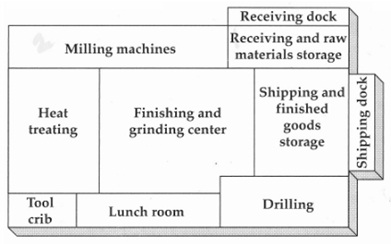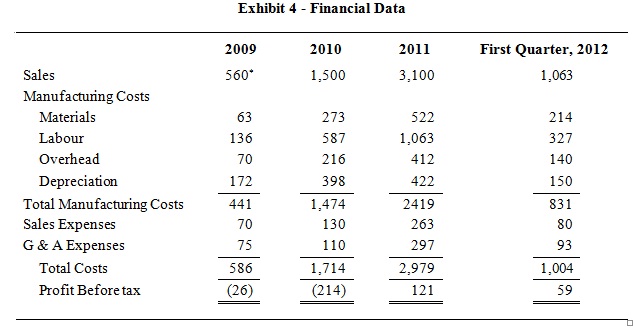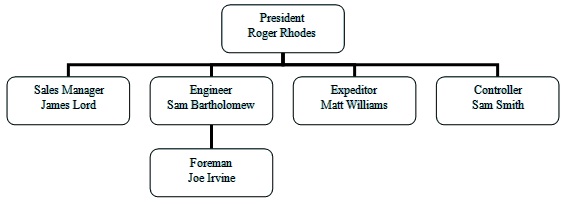Eastern Gear, Inc.:
Eastern gear Inc., in Philadelphia, Pa., is a manufacturer of custom made gears ranging in weight from a few ounces to over 50 pounds. The gears are made of different metals depending on the customer’s requirements. Over the past year 40 different types of steel and brass alloys have been used as raw materials. See Exhibit 1 for details.
Eastern gear sells its products primarily to engineering research and development laboratories or very small manufacturers. As a result the number of gears in most orders is small; rarely is exactly the same gear ordered more than once. The distribution of order sizes for March 2012 is shown in Exhibit 2.
Recently the president of Eastern Gear decided to accept a few larger orders for 100 gears or more. Although lower prices were accepted on these orders, they helped pay the overhead. It was found that the large orders caused many of the small orders to wait for a long time before being processed. As a result some deliveries of small orders were late.
Exhibit 1 - Raw Materials
Type of material 2011 usage $(000)
A $ 36
B 10
C 15
D 43
E 110
F 18
G 32
H 75
I 40
J 60
K 30
All others 53
Total $522
Order Entry:
When a customer wishes to order a gear, the order is taken by James Lord, sales manager and marketing vice president. The customer specifies the type of gear desired by submitting a blue print or sketch. The quantity of gears required and the type of material are also specified by the customer. On occasion the customers engineer will call up after the order has been placed and request a change in the design. In these cases, it may be necessary to stop production and wait for new raw materials or for the design to be clarified. The customers prints submitted with the order do not always contain the tolerances or finishes required during machining. As a result the customer is contacted directly when the information is needed.
After the order is received, one copy is sent to the production supervisor, Joe Irvine, and the second copy is sent to Sam Smith, the controller. Upon receipt of the customers order, Mr Smith places a purchase order for the raw materials required. These materials often take from 1 to 2 weeks to arrive, depending on the supplier and the type of material ordered.
After receiving the customer order, the supervisor reviews the order and places it on file until the raw material arrives. The customer order is then routed through the shop along with the materials. In the past the production process for most gears has taken about 2 weeks after receipt of raw materials. Recently this production time has increased to 4 weeks.
Joe Irvine expressed concern about the bottlenecks which appear in the production process. One week the bottleneck may be in one machine centre, and the next week it is in another. These bottlenecks make it difficult to get the orders out on time.
Exhibit 2 - Sales, March 2012
Order Size Number of Orders Total $ Value of Orders
1 80 3,200
2 53 4,250
3 69 8,163
4 32 4,800
5 82 16,392
8 47 15,987
10 64 26,871
15 22 13,172
20 42 31,555
25 27 23,682
30 18 21,600
40 22 32,000
50 10 18,693
100 4 12,500
200 2 14,068
400 1 9,652
700 2 35,600
1000 1 20,000
578 $312,185
Physical Layout and Materials Flow:
Eastern Gear utilizes a standard job-shop layout, as shown in Exhibit 3. Each work centre has a common set of machines or processes. The materials flow from one work centre to another, depending on the operations needed for a particular order.
A typical order will take the following path. First, the raw material, a gear blank, is sent to the milling work centre. Here the teeth are cut into the edge of the gear according to the customers specifications. Next the gear blanks are sent to the drilling works centre, where one or more holes may be drilled in the gear. The gear is then sent to a grinding centre, where a finish is put on the gear teeth and the surface of the gear. Next, the gear may be sent to heat treating if this operation is required by the customer. After the batch of gears is completed, they are inspected by the next available worker and shipped to the customer.
Exhibit 3 – Layout:

In Exhibit 3, note how the machines are grouped by similar type on the shop floor. For example all drills are located together in one work centre, and all milling machines are in another work centre. While this layout facilitates development of worker skills and training, it results in a jumbled flow of products through the shop.
There is constant interference of the orders being processed in the shop. The typical order spends 90 percent of its time waiting in line for a machine to become available. Only 10 percent of the time is actually spent processing the order on a machine. As a result it takes a relatively long time (4 weeks) for an order to make its way through the shop.
Large and small orders are processed together. No special work flow is utilised for different order sizes. As a matter of fact large orders are helping to keep the shop at full capacity.
Company Background:
Business has been booming at Eastern Gear. For the first two years the company lost money, but over the last several months a small profit has been made. Sales are up by 100 percent in the last quarter. See Exhibit 4 for more details.
Although sales are rapidly increasing, a recent market survey has indicated that sales can be expanded even more in the next few years. According to the market survey, sales will be $5 million in calendar year 1988 if the current delivery lead time of 5 to 6 weeks is maintained. If total delivery lead time can be reduced to the former 3 to 4 weeks, sales could be expanded to $5.5 million instead of $5million.
Because of increased delivery lead times, the company has recently added an expediter, Matt Williams. Each morning Matt reviews the work in progress in the shop and selects those orders which appear to be behind schedule. Each order which is behind receives a red tag, indicating that it should be treated on a rush basis. At the present time about 20 percent of the orders have rush tags on them. Mr. Williams also spends his time looking for past-due raw materials and lost orders as well as explaining late orders to customers.

The organization chart for the company is shown in Exhibit 5. Roger Rhodes is the president and founder of Eastern Gear. Mr Rhodes handles contacts with some of the large customers, arranges the financing needed by the company and sits in on the weekly production meeting. During these meetings, scheduling problems, employee problems, and other production problems are discussed.
The company engineer is Sam Bartholomew. His responsibilities include design of the company’s products, procurement and maintenance of equipment, and overseeing of the supervisor, Joe Irvine. Mr Bartholomew who attends the weekly production meetings, and he spends about ten hours a week on the factory floor talking with individual workers.
The company is currently experiencing about a six percent return rate on completed orders due to poor quality. In 75 percent of the cases the returned orders have failed to under go one or more operations or the operations have been improperly done. For example in one returned order, all the gears were missing a hole.
Occasionally, the company will receive rush orders from its customers. In this case the order is referred directly to Roger Rhodes for approval. If the order is accepted, the raw materials are rush-ordered and received the next day. After receipt of the raw materials, the order is rushed through production in 4 days. This is accomplished by Fred Dirkson, a trusted employee, who hand-carries the rush orders through all operations. About 10 percent of the orders are handled on a rush basis.
The work force consists of 50 employees who are highly skilled or semiskilled. The milling machine operators, for example, are highly skilled and require at least 2 years of vocational-technical training plus several months of on-the-job training. Within the last quarter, 10 new employees have been added to the work force. The employees are not unionized and good labour relations exist. The work force is managed using a family-type approach.
Exhibit - 5

QUESTIONS:
1. Evaluate Eastern Gear with operations strategic objectives and how would you like to make recommendations for any changes in the firm’s operations strategy?
2. Based on the diagnoses of Eastern Gear’s operations, what decisions should Mr Rhodes make to solve his problems in terms of (1) process and (2) quality?
3. Based on the diagnoses of Eastern Gear’s operations, what decisions should Mr Rhodes make to solve his problems in terms of (3) capacity and (4) inventory?
Instructions:
1. No more than 500 words are allowed in each answer.
2. Use Times New Roman, 12-point, single-spaced with margins of 2.54 cm.
3. Citations: Refer to textbook page(s) and line(s), or PowerPoint slide(s)
4. In case you wish to support your arguments with information outside our textbook or PowerPoint, follow the APA style and make References.
1. Evaluate Eastern Gear with operations strategic objectives and how would you like to make recommendations for any changes in the firm’s operations strategy?
2. Based on the diagnoses of Eastern Gear’s operations, what decisions should Mr Rhodes make to solve his problems in terms of (1) process and (2) quality?
3. Based on the diagnoses of Eastern Gear’s operations, what decisions should Mr Rhodes make to solve his problems in terms of (3) capacity and (4) inventory?